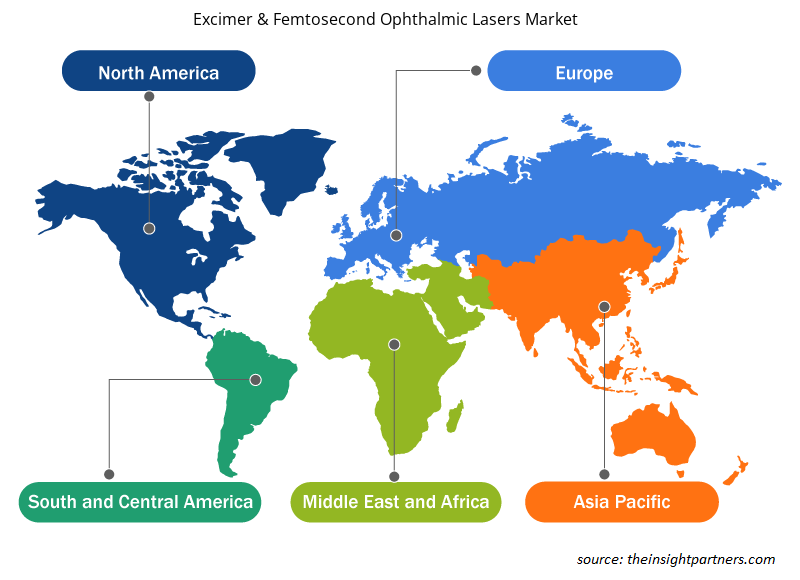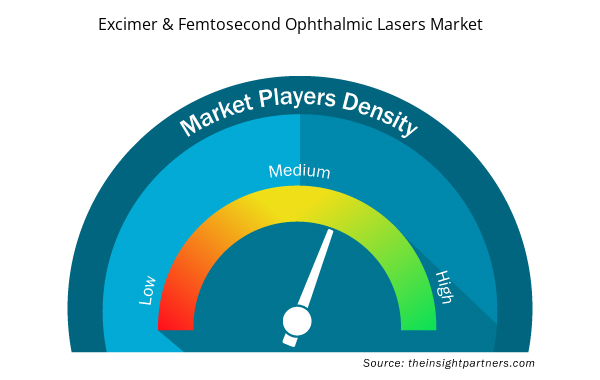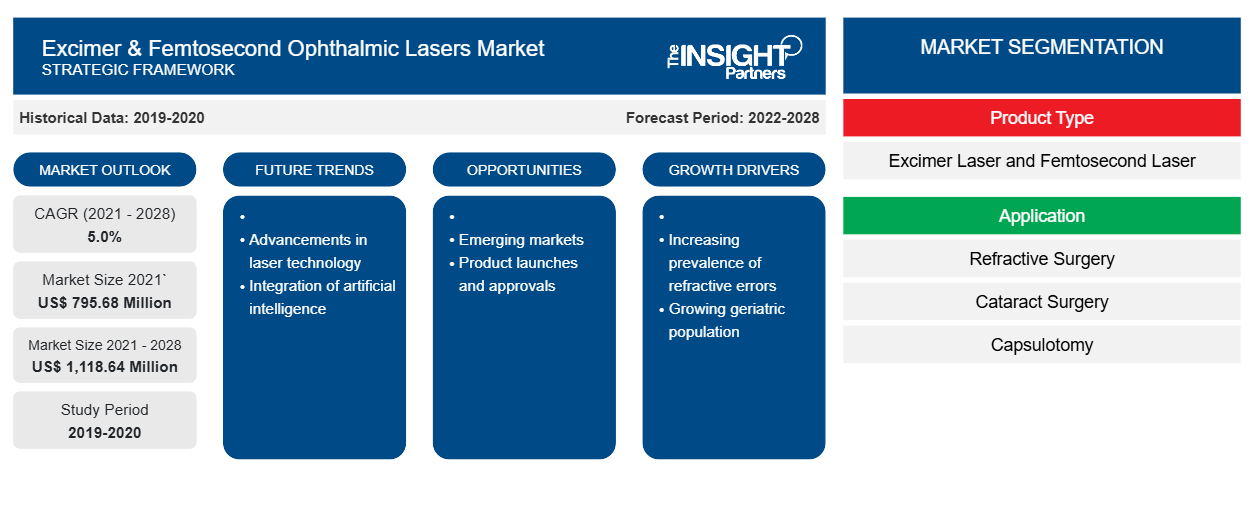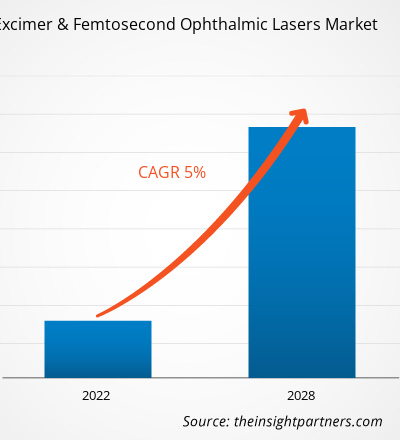Se espera que el mercado de láseres oftálmicos excimer y femtosegundo alcance los US$ 1.118,64 millones para 2028 desde los US$ 795,68 millones en 2021; se estima que crecerá a una CAGR del 5,0% durante 2021 a 2028.
La tecnología láser se utiliza en muchas disciplinas y especialidades médicas y desempeña un papel importante en la promoción del avance de la oftalmología, especialmente en la cirugía refractiva corneal. El láser oftalmológico es de dos tipos, como el láser excimer, la queratectomía fotorrefractiva (PRK), la queratomileusis epitelial láser (LASEK), la queratomileusis in situ con láser epipolis (Epi-LASIK) y la queratectomía fotorrefractiva transepitelial (Trans-PRK) y la cirugía de presbicia) y el láser femtosegundo, como la queratomileusis in situ con láser femtosegundo (FS-LASIK), la inserción de segmentos de anillo intracorneales, la extracción de lentículos con incisión pequeña (SMILE) y la extracción de lentículos con femtosegundo (Flex).
Cobertura del informe
El crecimiento del mercado de láseres oftálmicos de excímeros y femtosegundos se atribuye a factores como el aumento de la población de edad avanzada y el aumento de la cantidad de cirugías refractivas y de cataratas. Sin embargo, el alto costo de las cirugías y los dispositivos oftálmicos obstaculiza el crecimiento del mercado.
Personalice este informe según sus necesidades
Obtendrá personalización en cualquier informe, sin cargo, incluidas partes de este informe o análisis a nivel de país, paquete de datos de Excel, así como también grandes ofertas y descuentos para empresas emergentes y universidades.
- Obtenga las principales tendencias clave del mercado de este informe.Esta muestra GRATUITA incluirá análisis de datos, desde tendencias del mercado hasta estimaciones y pronósticos.
Perspectivas del mercado
Aumento significativo de la población de edad avanzada
El aumento de la población geriátrica en países como Estados Unidos, Reino Unido, Canadá, Japón, China, India y Corea del Sur está impulsado por la modernización de las instalaciones sanitarias y las mejoras en los servicios de salud, lo que aumenta la esperanza de vida en estos países. Según los datos de la OMS de febrero de 2018, se estima que la población geriátrica aumentará del 12 % en 2015 al 22 % en 2050. Según la Oficina del Censo de Estados Unidos, se prevé que el número de personas en Estados Unidos con 65 años o más crezca de 46 millones en 2016 a más de 98 millones en 2060, mientras que su participación en la población crecería de ~15 % a ~24 % durante este período. Según el informe World Population Ageing 2017 de las Naciones Unidas, en 2017, Europa tenía el porcentaje más alto del mundo (es decir, el 25 %) de personas mayores de 60 años. Además, para 2050, todas las regiones del mundo, excepto África, tendrán aproximadamente el 25% o más de su población con 60 años o más, y los países subdesarrollados y en desarrollo representarán aproximadamente el 80% de este crecimiento.
La pérdida de visión es un problema de salud importante entre las personas mayores. La degeneración macular relacionada con la edad, el glaucoma, las cataratas y la retinopatía diabética se encuentran entre las causas más comunes de pérdida de visión entre las personas de este grupo de edad. La degeneración macular relacionada con la edad produce la pérdida de la visión central. La lesión del nervio óptico y la pérdida del campo visual pueden ocurrir como resultado del glaucoma primario de ángulo abierto. Como esta dolencia puede ser asintomática al principio, las personas mayores necesitan controles regulares. Aunque las cataratas son la fuente común de problemas visuales en estas personas, sin embargo, las cataratas generalmente se pueden eliminar mediante procedimientos quirúrgicos. La retinopatía diabética también es común entre las personas mayores durante las primeras etapas de la diabetes o en el momento del diagnóstico. Se recomienda un examen midriático cuando a un paciente se le diagnostica diabetes, seguido de una visita anual a partir de entonces.
Según el Instituto Americano de Oftalmología, aproximadamente 24,4 millones de personas menores de 40 años se someten a una cirugía de cataratas, y aproximadamente el 5% de todos los estadounidenses se someten a una cirugía de cataratas antes de los 75 años. Además, los casos de glaucoma están aumentando y la afección afecta a más de 2,7 millones de estadounidenses de 40 años o más. Las nuevas enfermedades oculares, como la degeneración macular relacionada con la edad, que afecta a más de 2,1 millones de estadounidenses de 50 años o más, pueden causar una pérdida grave de la visión. Por lo tanto, existe una adopción significativamente alta de nuevas tecnologías, como los láseres de femtosegundo, en la cirugía de cataratas, que implica una gran inversión inicial pero promete mejoras en los resultados del paciente. Por lo tanto, el aumento de la población geriátrica impulsa el crecimiento del mercado de láseres oftálmicos de excimer y femtosegundo.
Información basada en el tipo de producto
Según el tipo de producto, el mercado de láseres oftálmicos de excímeros y femtosegundos se segmenta en láser de excímeros y láser de femtosegundos. Se espera que el segmento de láseres de femtosegundos lidere el mercado en 2021 y mantenga su dominio durante el período 2021-2028. Además, también se espera que el mismo segmento crezca al ritmo más rápido durante los próximos años.
Perspectivas basadas en aplicaciones
Según la aplicación, el mercado de láseres oftálmicos de excímeros y femtosegundos se segmenta en cirugía refractiva, cirugía de cataratas, capsulotomía, trabeculoplastia y diagnóstico. Se prevé que el segmento de cirugía refractiva tenga la mayor participación del mercado en 2021, mientras que se estima que el segmento de cirugía de cataratas registrará la CAGR más alta del mercado durante el período de pronóstico.
Información basada en el usuario final
Según el usuario final, el mercado de láseres oftálmicos de excímeros y femtosegundos está segmentado en hospitales, clínicas oftálmicas y centros quirúrgicos ambulatorios. Se estima que el segmento de hospitales tendrá la mayor participación del mercado en 2021. Sin embargo, se estima que el segmento de clínicas oftálmicas registrará la CAGR más alta del mercado durante el período de pronóstico.
Los lanzamientos y las aprobaciones de productos son estrategias que suelen adoptar las empresas para ampliar su presencia global y sus carteras de productos. Las empresas del mercado de láseres oftálmicos de femtosegundo y excimer se centran en la estrategia de colaboración para ampliar su clientela, lo que, a su vez, les permite mantener su marca en todo el mundo.
Láseres oftálmicos de excímeros y femtosegundos
Perspectivas regionales del mercado de láseres oftálmicos de excímeros y femtosegundos
Los analistas de Insight Partners explicaron en detalle las tendencias y los factores regionales que influyen en el mercado de láseres oftálmicos de excímeros y femtosegundos durante el período de pronóstico. Esta sección también analiza los segmentos y la geografía del mercado de láseres oftálmicos de excímeros y femtosegundos en América del Norte, Europa, Asia Pacífico, Oriente Medio y África, y América del Sur y Central.

- Obtenga datos regionales específicos para el mercado de láseres oftálmicos de excímeros y femtosegundos
Alcance del informe de mercado de láseres oftálmicos de excímeros y femtosegundos
| Atributo del informe | Detalles |
|---|---|
| Tamaño del mercado en 2021 | US$ 795,68 millones |
| Tamaño del mercado en 2028 | US$ 1.118,64 millones |
| CAGR global (2021-2028) | 5.0% |
| Datos históricos | 2019-2020 |
| Período de pronóstico | 2022-2028 |
| Segmentos cubiertos | Por tipo de producto
|
| Regiones y países cubiertos | América del norte
|
| Líderes del mercado y perfiles de empresas clave |
|
Densidad de actores del mercado de láseres oftálmicos de excímeros y femtosegundos: comprensión de su impacto en la dinámica empresarial
El mercado de láseres oftálmicos de excímeros y femtosegundos está creciendo rápidamente, impulsado por la creciente demanda de los usuarios finales debido a factores como la evolución de las preferencias de los consumidores, los avances tecnológicos y una mayor conciencia de los beneficios del producto. A medida que aumenta la demanda, las empresas amplían sus ofertas, innovan para satisfacer las necesidades de los consumidores y aprovechan las tendencias emergentes, lo que impulsa aún más el crecimiento del mercado.
La densidad de actores del mercado se refiere a la distribución de las empresas o firmas que operan dentro de un mercado o industria en particular. Indica cuántos competidores (actores del mercado) están presentes en un espacio de mercado determinado en relación con su tamaño o valor total de mercado.
Las principales empresas que operan en el mercado de láseres oftálmicos excimer y femtosegundo son:
- Empresas de salud Bausch Inc.
- Compañía Alcon Inc.
- ZEISS Internacional
- Compañía Nidek Ltd.
- TECNOLOGÍAS IVIS
Descargo de responsabilidad : Las empresas enumeradas anteriormente no están clasificadas en ningún orden particular.

- Obtenga una descripción general de los principales actores clave del mercado de láseres oftálmicos de excímeros y femtosegundos
Mercado de láseres oftálmicos de excímeros y femtosegundos: por tipo de producto
- Láser de femtosegundo
- Láser excimer
Mercado de láseres oftálmicos de excímeros y femtosegundos: por aplicación
- Cirugía refractiva
- Cirugía de cataratas
- Capsulotomía
- Trabeculoplastia
- Diagnóstico
Mercado de láseres oftálmicos de excímeros y femtosegundos: por usuario final
- Hospitales
- Clínicas oftalmológicas
- Centros de cirugía ambulatoria
Mercado de láseres oftálmicos de excímeros y femtosegundos: por geografía
- América del norte
- A NOSOTROS
- Canadá
- México
- Europa
- Asia Pacífico (APAC)
- Oriente Medio y África (MEA)
- América del Sur y Central (SCAM)
Perfiles de empresas
- Empresas de salud Bausch Inc.
- Compañía Alcon Inc.
- ZEISS Internacional
- Compañía Nidek Ltd.
- TECNOLOGÍAS IVIS
- EXCELSIUS MEDICAL GMBH
- Sistemas oftálmicos Ziemer
- SOLUCIONES TECNOLÓGICAS SCHWIND
- LENSAR, Inc.
- NKT Photonics A/S
- Análisis histórico (2 años), año base, pronóstico (7 años) con CAGR
- Análisis PEST y FODA
- Tamaño del mercado Valor/volumen: global, regional, nacional
- Industria y panorama competitivo
- Conjunto de datos de Excel


- Long Read Sequencing Market
- Biopharmaceutical Contract Manufacturing Market
- Volumetric Video Market
- USB Device Market
- Predictive Maintenance Market
- UV Curing System Market
- Medical and Research Grade Collagen Market
- Medical Enzyme Technology Market
- Formwork System Market
- Portable Power Station Market

Report Coverage
Revenue forecast, Company Analysis, Industry landscape, Growth factors, and Trends

Segment Covered
This text is related
to segments covered.

Regional Scope
North America, Europe, Asia Pacific, Middle East & Africa, South & Central America

Country Scope
This text is related
to country scope.
Preguntas frecuentes
The excimer & femtosecond ophthalmic lasers market majorly consists of the players such as Bausch Health Companies Inc., Alcon Inc., ZEISS International, NIDEK CO., LTD, IVIS TECHNOLOGIES, EXCELSIUS MEDICAL GMBH, Ziemer Ophthalmic Systems, SCHWIND EYE-TECH-SOLUTIONS, LENSAR, Inc., and NKT Photonics A/S among others.
Factors such as the significant rise in elderly population and increase in the number of cataract and refractive surgeries are driving the market growth.
The excimer & femtosecond ophthalmic lasers market is segmented into North America, Europe, Asia Pacific, Middle East & Africa, and South & Central America. In North America, the US holds the largest size of the excimer & femtosecond ophthalmic lasers market. North America held a prominent position in the global market due to growing healthcare expenditure in the US and the development of world-class healthcare infrastructure. Further, the growing prevalence of ophthalmic disorders is anticipated to underpin the demand for these products in the regions. The Asia Pacific region is expected to account for the fastest growth in the excimer & femtosecond ophthalmic lasers market. The market in the Asia Pacific region is expected to grow at a quicker pace due to factors such as rapid growth in the geriatric population, the rise in healthcare awareness about the importance of eye health, and the increase in the number of cataracts refractive surgeries.
The refractive surgery segment dominated the global excimer & femtosecond ophthalmic lasers market and held the largest revenue share in 2021. However, the cataract surgery segment is expected to grow at the fastest rate during the coming years.
Excimer Laser eye surgery is a treatment to correct nearsightedness, farsightedness, or astigmatism. The surgery reduces or eliminates the need to wear contact lenses or glasses. In this surgery, the rays of invisible ultraviolet light from the excimer laser remove a minimal quantity of tissue from the cornea to correct the curvature. This process is known as photo ablative decomposition.
Similarly, a femtosecond laser, an infrared laser, emits bursts of laser energy at a high-speed rate. A femtosecond laser has a pulse span in the femtosecond range or one quadrillionth of a second. Femtosecond Lasers are widely used for cataract surgery. The U.S. Federal Drug Administration (FDA) approved Femtosecond Lasers Assisted Cataract Surgery (FLACS) in 2010. According to the WHO, cataract is the leading cause of blindness globally, and nearly 18 million people are bilaterally blind from cataract.
Hospitals, ambulatory surgical centers, and ophthalmology clinics are key end users of excimer & femtosecond ophthalmic lasers. Hospitals offer various treatments for different eye conditions. An ophthalmologist in these hospitals treats thousands of patients with a wide variety of eye conditions. Thus, the hospitals segment led the market in 2021 and is expected to retain its dominance during the forecast period.
Trends and growth analysis reports related to Life Sciences : READ MORE..
The List of Companies - Excimer & Femtosecond Ophthalmic Lasers Market
- Bausch Health Companies Inc.
- Alcon Inc.
- ZEISS International
- NIDEK CO., LTD
- IVIS TECHNOLOGIES
- EXCELSIUS MEDICAL GMBH
- Ziemer Ophthalmic Systems
- SCHWIND EYE-TECH-SOLUTIONS
- LENSAR, Inc.
- NKT Photonics A/S
The Insight Partners performs research in 4 major stages: Data Collection & Secondary Research, Primary Research, Data Analysis and Data Triangulation & Final Review.
- Data Collection and Secondary Research:
As a market research and consulting firm operating from a decade, we have published and advised several client across the globe. First step for any study will start with an assessment of currently available data and insights from existing reports. Further, historical and current market information is collected from Investor Presentations, Annual Reports, SEC Filings, etc., and other information related to company’s performance and market positioning are gathered from Paid Databases (Factiva, Hoovers, and Reuters) and various other publications available in public domain.
Several associations trade associates, technical forums, institutes, societies and organization are accessed to gain technical as well as market related insights through their publications such as research papers, blogs and press releases related to the studies are referred to get cues about the market. Further, white papers, journals, magazines, and other news articles published in last 3 years are scrutinized and analyzed to understand the current market trends.
- Primary Research:
The primarily interview analysis comprise of data obtained from industry participants interview and answers to survey questions gathered by in-house primary team.
For primary research, interviews are conducted with industry experts/CEOs/Marketing Managers/VPs/Subject Matter Experts from both demand and supply side to get a 360-degree view of the market. The primary team conducts several interviews based on the complexity of the markets to understand the various market trends and dynamics which makes research more credible and precise.
A typical research interview fulfils the following functions:
- Provides first-hand information on the market size, market trends, growth trends, competitive landscape, and outlook
- Validates and strengthens in-house secondary research findings
- Develops the analysis team’s expertise and market understanding
Primary research involves email interactions and telephone interviews for each market, category, segment, and sub-segment across geographies. The participants who typically take part in such a process include, but are not limited to:
- Industry participants: VPs, business development managers, market intelligence managers and national sales managers
- Outside experts: Valuation experts, research analysts and key opinion leaders specializing in the electronics and semiconductor industry.
Below is the breakup of our primary respondents by company, designation, and region:

Once we receive the confirmation from primary research sources or primary respondents, we finalize the base year market estimation and forecast the data as per the macroeconomic and microeconomic factors assessed during data collection.
- Data Analysis:
Once data is validated through both secondary as well as primary respondents, we finalize the market estimations by hypothesis formulation and factor analysis at regional and country level.
- Macro-Economic Factor Analysis:
We analyse macroeconomic indicators such the gross domestic product (GDP), increase in the demand for goods and services across industries, technological advancement, regional economic growth, governmental policies, the influence of COVID-19, PEST analysis, and other aspects. This analysis aids in setting benchmarks for various nations/regions and approximating market splits. Additionally, the general trend of the aforementioned components aid in determining the market's development possibilities.
- Country Level Data:
Various factors that are especially aligned to the country are taken into account to determine the market size for a certain area and country, including the presence of vendors, such as headquarters and offices, the country's GDP, demand patterns, and industry growth. To comprehend the market dynamics for the nation, a number of growth variables, inhibitors, application areas, and current market trends are researched. The aforementioned elements aid in determining the country's overall market's growth potential.
- Company Profile:
The “Table of Contents” is formulated by listing and analyzing more than 25 - 30 companies operating in the market ecosystem across geographies. However, we profile only 10 companies as a standard practice in our syndicate reports. These 10 companies comprise leading, emerging, and regional players. Nonetheless, our analysis is not restricted to the 10 listed companies, we also analyze other companies present in the market to develop a holistic view and understand the prevailing trends. The “Company Profiles” section in the report covers key facts, business description, products & services, financial information, SWOT analysis, and key developments. The financial information presented is extracted from the annual reports and official documents of the publicly listed companies. Upon collecting the information for the sections of respective companies, we verify them via various primary sources and then compile the data in respective company profiles. The company level information helps us in deriving the base number as well as in forecasting the market size.
- Developing Base Number:
Aggregation of sales statistics (2020-2022) and macro-economic factor, and other secondary and primary research insights are utilized to arrive at base number and related market shares for 2022. The data gaps are identified in this step and relevant market data is analyzed, collected from paid primary interviews or databases. On finalizing the base year market size, forecasts are developed on the basis of macro-economic, industry and market growth factors and company level analysis.
- Data Triangulation and Final Review:
The market findings and base year market size calculations are validated from supply as well as demand side. Demand side validations are based on macro-economic factor analysis and benchmarks for respective regions and countries. In case of supply side validations, revenues of major companies are estimated (in case not available) based on industry benchmark, approximate number of employees, product portfolio, and primary interviews revenues are gathered. Further revenue from target product/service segment is assessed to avoid overshooting of market statistics. In case of heavy deviations between supply and demand side values, all thes steps are repeated to achieve synchronization.
We follow an iterative model, wherein we share our research findings with Subject Matter Experts (SME’s) and Key Opinion Leaders (KOLs) until consensus view of the market is not formulated – this model negates any drastic deviation in the opinions of experts. Only validated and universally acceptable research findings are quoted in our reports.
We have important check points that we use to validate our research findings – which we call – data triangulation, where we validate the information, we generate from secondary sources with primary interviews and then we re-validate with our internal data bases and Subject matter experts. This comprehensive model enables us to deliver high quality, reliable data in shortest possible time.


 Obtenga una muestra gratuita de este informe
Obtenga una muestra gratuita de este informe